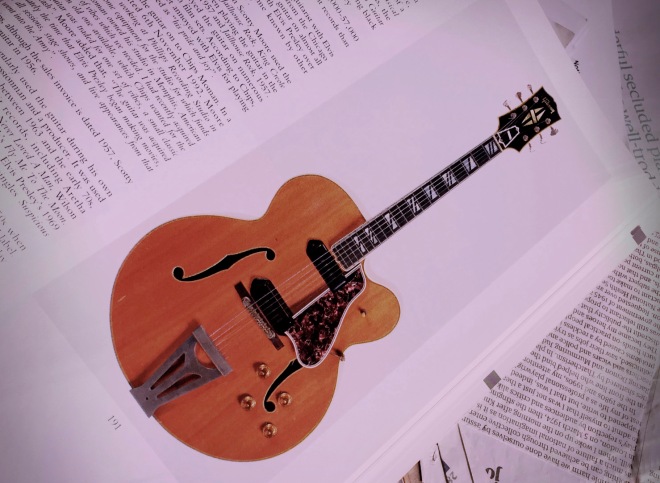ONE I THINK WE’VE REACHED PEAK ROCK ’N’ ROLL…
Complete with a David Bowie tribute (why?) a drugstore guide (wrong kind of drug reference, no?) and, from the glorious inside pages, a typical R ’n’ R Bride pull quote.
TWO CHIPS MOMAN, R.I.P.
At the turn of the millennium Chips Moman sold some of his astonishing guitar collection at Christies. My pal Mark went along, said Hi to Chips, didn’t bid, gave me the catalogue. Here is the jewel of the collection, although for me it was given a run for its money by the Coral Sitar, as featured on From Elvis in Memphis (where it was played by the sublime Reggie Young) and on “Cry Like a Baby” by The Box Tops.

The price realised by the 1956 Gibson Super 400 CES was a staggering £67,550, but as the man says, “This guitar is believed to have been used on more hit records than any other comparable instrument in pop history.” Originally purchased by Scotty Moore, the guitarist with Elvis Presley’s backing band, it became known by other musicians and fans as “the blonde Elvis guitar.” Among the Presley records on which Scotty Moore used the guitar were All Shook Up, Loving You, Jailhouse Rock, King Creole and One Night. In addition, Scotty is seen playing the guitar in the Elvis Presley feature films Loving You and Jailhouse Rock. According to Chips, Moore would get annoyed with Elvis for playing around with the guitar he described as “his pride and joy.” Scotty: “In 1963, I was working at Phillips Recording Studio in Memphis, TN. We needed some equipment for the studio for which funds were not available. Chips Moman owned his studio in Memphis, American, and he had the set of vibes which we needed. I had recently acquired a new guitar and had the old one available, which Chips wanted for the historical value. The guitar was traded for one set of vibes, a small classic guitar, and $80.00 cash.” Was that ever a bargain…
Chips regularly used the guitar during his own recording sessions, both as a player and a producer. It was used on literally hundreds of sessions between 1963 and the early 70s, appearing on several hundred hit records, including Aretha Franklin’s “Do Right Woman” and “Never Loved A Man” and Wilson Pickett’s “Mustang Sally.” Session guitarist Reggie Young played the guitar on Elvis’s 1969 sessions in Memphis, which produced the hit singles “Suspicious Minds” and “In The Ghetto.”
THREE SOUND OF THE WEEK
Working with French photographer Lionel Derimais on a book project about his time living in China, he shows me this: flocks of pigeons in Beijing, with whistles attached to their tail feathers.
FOUR WHILE I’M HAPPY TO HAVE MORE FROM THE VAN VAULTS…
…in the shape of It’s Too Late To Stop Now Volumes II, III and IV, I’ve got to say that the packaging sucks. There are seventeen photos of Van (yes, I counted them), all essentially variations of the same shot, but none of the wonderful Caledonian Soul Orchestra (unless you count a couple of fuzzy B&W’s of saxophonist Jack Shroer). Why downgrade the input of one of the great bands in rock? Also, there’s just a perfunctory liner note, but no context-setting essay, no reminiscences – in short, no great effort. I still have to watch the DVD of the Rainbow show, but hey – poor work, Sony Legacy. In the music player to the right, hear the Orchestra awesomely funk up “Sweet Thing” as John Platania’s guitar and David Hayes’ bass burn up the Rainbow.
FIVE BOB FINALLY PLAYS A REQUEST SHOUTED OUT FROM THE AUDIENCE!
It’s just not for one of his songs… In other Bob news, this sent by Bob G: Mikael Wood in the LA Times site on Dylan at the Shrine: “What a treat it was to hear someone at this stage in his career playing what excites him now rather than what excited him 3 million years ago.”
For the full 5 Things experience, please click on the Date Headline of the page in the email and you will go to the proper site (which allows you to see the Music Player). Also all the links will open in another tab or window in your browser.










![I’ve just posted my memories of working with the wonderful illustrator and painter Paul Slater on my Adventures in Commissioning blog [Google adventures | commissioning | colyer]. Paul was an amazing painter and illustrator, and it was a privilege to work with him. I’ve put some of the pieces we did together here, and a selection of details from one in particular, a map for tourists that could have been bland and pretty, but was elevated by Paul’s brilliance.](https://scontent-iad3-1.cdninstagram.com/v/t51.82787-15/573918918_18080720717012756_3004912060508284177_n.jpg?stp=dst-jpg_e35_tt6&_nc_cat=104&ccb=7-5&_nc_sid=18de74&efg=eyJlZmdfdGFnIjoiQ0FST1VTRUxfSVRFTS5iZXN0X2ltYWdlX3VybGdlbi5DMyJ9&_nc_ohc=jf47iBiX3Y8Q7kNvwFCOFnb&_nc_oc=AdnzD-Hs5YmOjtbf36fdMNGFme7CmLlC6pUr9kzqA1HUFSx3Wk9ZQlcuzRokSmIqE58&_nc_zt=23&_nc_ht=scontent-iad3-1.cdninstagram.com&edm=ANo9K5cEAAAA&_nc_gid=W94OnEjvxNG-jxeIA2Bwcw&oh=00_AfpBjstRBMaGkTeLXl7gj6HDAu0ddEZsx0SFwa35md2G2w&oe=695E3518)




Great as it is to finally have three extra volumes and a DVD of ‘It’s Too Late to Stop No’ after nearly 45 years, you are so right that the package is perfunctory, even disrespectful, regarding context (and also annoying in its engineering: one long unfolding strip of digipack panels). I especially want to know what happens on ‘Buona Sera’ in the Rainbow set. It’s like a dixie band suddenly arrives, with extra trumpets and even what sounds like a clarinet (maybe Jack Schroer playing soprano): there seem to be more musicians playing than were in the band.
Ha! I must listen more carefully to that, Chris, I think I skipped all the versions of “Buona Sera”!